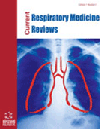- Home
- A-Z Publications
- Current Respiratory Medicine Reviews
- Previous Issues
- Volume 12, Issue 1, 2016
Current Respiratory Medicine Reviews - Volume 12, Issue 1, 2016
Volume 12, Issue 1, 2016
-
-
Occupational Exposure and Respiratory Tract Infections –At Risk Workers in the International Context
More LessBy Tor B. AasenInfectious diseases transmitted at work are frequent globally. Lung infections due to exposure at work are mainly affecting two broad groups, health care workers (HCW) and people exposed occasionally to sick animals. The main challenge globally during the last decades has been tuberculosis (TB), different influenza strains and coronaviruses. TB is still a global threat infecting almost 9 mill people world-wide and ca Read More
-
-
-
Occupational Exposure and Occupational Asthma: Difference in Practices in Developed Countries v/s Developing Countries
More LessOccupational asthma (OA) has emerged as the commonest occupational lung disease in developed countries and the second commonest in developing countries. Nearly 9-15% of the global adult asthma is occupation associated. However, this is an underestimation as large proportion of occupational asthma remains unidentified in developing world. The economic burden of OA is enormous but the disease is potentially pr Read More
-
-
-
Occupational Respiratory Pathology in Russia: Current Trends and Challenges
More LessIn the morbidity structure of Russian adult population respiratory disorders are second only to circulatory system diseases. Point prevalence of respiratory diseases was registered at 38,945 per 100,000 people in 2013. 4% of all deaths annually in Russia are due to the respiratory pathology. Risk factors are numerous but principal among them are infections, workplace conditions, environmental pollution, behavioral patterns Read More
-
-
-
Asbestos-Related Diseases: Still a Concern in Emerging Economies in the Absence of an International Ban
More LessAsbestos has been known for many years to cause a range of both non-malignant and malignant diseases. Over fifty countries have totally banned the use of asbestos, but in emerging economies there continues to be considerable use of asbestos. Unfortunately, the United States is one of the very few developed countries that has not banned the use of this material due to industry intransigence. With the continued use of asbe Read More
-
-
-
An Update on Hypersensitivity Pneumonitis
More LessBy Mridu GulatiHypersensitivity pneumonitis is a form of interstitial lung disease caused by a wide array of respirable particles. Given the widespread prevalence of many implicated exposures, contributing factors such as genetic predisposition and concomitant environmental factors likely influence the risk of disease development. Common causes include a range of bacterial and fungal species, and a number of chemical exposures such as to Read More
-
-
-
Industrial Chemicals and Acute Lung injury with a Focus on Exposure Scenarios
More LessAuthors: Yangjin Jegal and Yangho KimIn industrialized countries, inhalational exposure to various industrial chemicals is commonplace, with acute lung injury from industrial chemicals increasing in parallel to industrialization. Most acute toxic inhalation, both in industrial and home settings, is due directly to leaks or spills or indirectly to reaction products such as nitrogen dioxide and phosgene. Acute pulmonary parenchymal injuries range from mild pneumon Read More
-
-
-
Silicosis in Current Scenario: A Review of Literature
More LessAuthors: Sukanta Sen, Ritabrata Mitra, Shatavisa Mukherjee, Prasanta K. Das and Saibal MoitraSilicosis is one of the oldest occupational diseases known to man. It is an irreversible fibrotic lung disease caused by inhalation of crystalline silicon dioxide or silica. In spite of optimal regulation in the developed countries, exposure to respirable crystalline silica dust is still a major occupational health problem however the scenario is far more adverse in the industrially developing countries. The USA, Europe, China and India are Read More
-
-
-
Coal Mine Dust Lung Disease: The Silent Coal Mining Disaster
More LessAuthors: Clara J. Schroedl, Leonard H.T. Go and Robert A. CohenCoal is the second largest source of energy worldwide. As global energy demands continue to rise, coal will remain an important fuel source for years to come. Coal mine dust lung disease (CMDLD) describes the spectrum of respiratory diseases caused by coal mine dust and includes coal workers’ pneumoconiosis (CWP), mixed-dust pneumoconiosis, chronic obstructive pulmonary disease (COPD), and diffuse dust-related fi Read More
-
-
-
Risk Factors for Lung Cancer in Never Smokers: A Recent Review Including Genetics
More LessAuthors: Anne Marie Quinn, William G. Newman and Philip S. HasletonLung cancer, a disease traditionally attributed to the effects of carcinogens from inhaled tobacco smoke, is now recognised in a population with either a relatively light history of smoking, or never smoking. Although second hand smoke contributes to the risk of neoplasia, the extent to which this affects different individuals varies, and probably depends on a combination of genetic, environmental, and racial factors. In addition, Read More
-
Volumes & issues
-
Volume 21 (2025)
-
Volume 20 (2024)
-
Volume 19 (2023)
-
Volume 18 (2022)
-
Volume 17 (2021)
-
Volume 16 (2020)
-
Volume 15 (2019)
-
Volume 14 (2018)
-
Volume 13 (2017)
-
Volume 12 (2016)
-
Volume 11 (2015)
-
Volume 10 (2014)
-
Volume 9 (2013)
-
Volume 8 (2012)
-
Volume 7 (2011)
-
Volume 6 (2010)
-
Volume 5 (2009)
-
Volume 4 (2008)
-
Volume 3 (2007)
-
Volume 2 (2006)
-
Volume 1 (2005)
Most Read This Month
Article
content/journals/crmr
Journal
10
5
false
en


